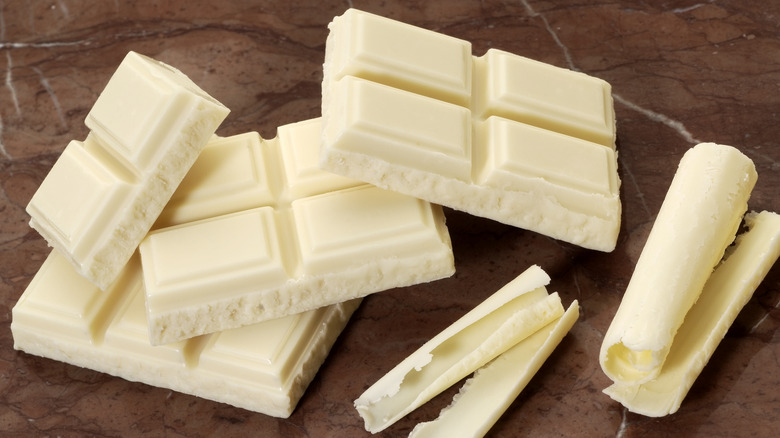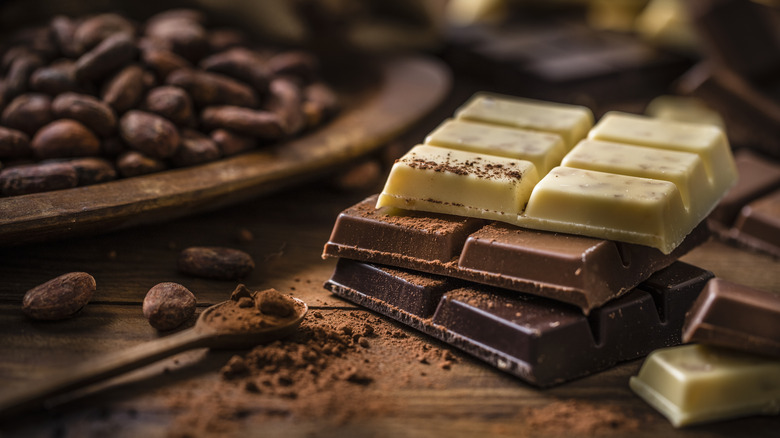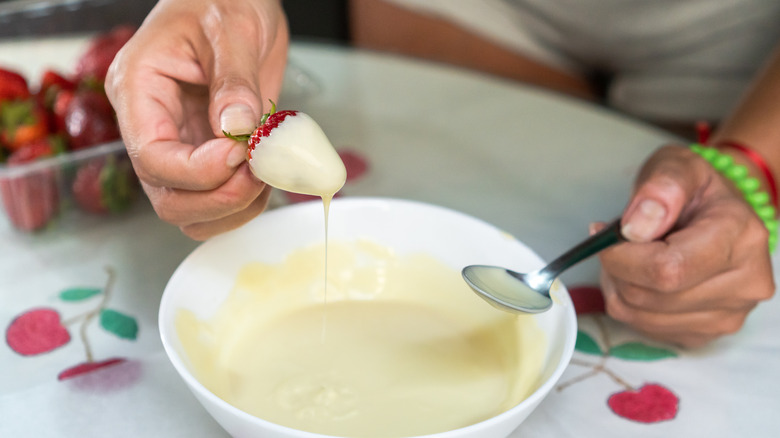Is White Chocolate Real Chocolate? The Answer Is Complicated
A chocolate taste test is the best way to explore the nuanced flavors and textures of different chocolate types. When you have a lineup of milk, dark, and white chocolate, one of the three will always stand out: White chocolate has a different flavor, ingredient list, texture, and melting point than milk or dark chocolate — leading some to question whether white chocolate is really chocolate at all.
It's not the only type of chocolate that gets bashed on, but white chocolate's unique color defies people's expectations of what chocolate should look like. Additionally, most of the flavor in milk and dark chocolate comes from cocoa solids, which aren't used in white chocolate. The list of what makes white chocolate different seems lengthy, but whether or not something is considered chocolate comes down to the origin of its ingredients and its classification by government entities.
White chocolate is sourced from the same beans as milk or dark chocolate. It also uses an identical manufacturing process as all other kinds of chocolate up until the stage where the cocoa solids are separated from the cocoa butter. The United States Food and Drug Administration categorizes white chocolate alongside other types of chocolate based on its composition of cocoa-based ingredients. By these criteria, white chocolate is in fact chocolate, but something about calling it "chocolate" defies our intuitions.
What defines chocolate?
All chocolate starts as roasted cacao beans. A cacao pod's seeds (sometimes called beans) are harvested, fermented, roasted, and ground down to make a smooth substance called cocoa paste or chocolate liquor. "Cacao" refers to the raw fruit and "cocoa" refers to products from the roasted pod. Milk and dark chocolate make use of whole chocolate liquor, whereas white chocolate requires processing the chocolate liquor through a hydraulic press. This separates the cocoa butter from the cocoa solids.
Dark chocolate contains cocoa liquor, cocoa butter, and sugar; milk chocolate has the same but incorporates milk solids; and white chocolate ditches the cocoa liquor in favor of a higher concentration of milk. Despite the differences in color and flavor, all varieties of chocolate contain cocoa butter as a central ingredient. Some white chocolate naysayers argue that it is the presence of cocoa solids that makes chocolate, well, chocolate — but it is worth noting that cocoa butter constitutes half of the weight of cocoa beans.
Chocolate (including white chocolate) is categorized under the umbrella of "cacao products" by the FDA. For something to be classified as white chocolate, it must be at least 20% cacao fat and 14% milk solids and cannot be more than 55% sugar. There's no mention of requiring cocoa power or solids in any other in order to earn the label as a cacao product.
It's a matter of semantics
Many of the voices claiming that white chocolate isn't chocolate lean on the argument that cocoa butter doesn't infuse white chocolate with any of the familiar, chocolatey flavors that come from cocoa solids. However, the definition of chocolate refers to a food's origins from roasted cacao beans. Both cocoa butter and cocoa solids are derived from roasted cacao beans. Flavor critiques aside, white chocolate meets the definition of being chocolate.
It doesn't take a scientist to tell us that there is something fundamentally different about white chocolate compared with milk or even dark chocolate. Yes, the three are easily identifiable by their distinct colors, but it's the different concentrations of cocoa butter and cocoa solids that give each one its identity. That said, they are all equally chocolate. Based on the legal categorization of cacao products and the fact that white chocolate starts as roasted cacao beans, it seems that this sweet food, both in name and composition, really is chocolate.


